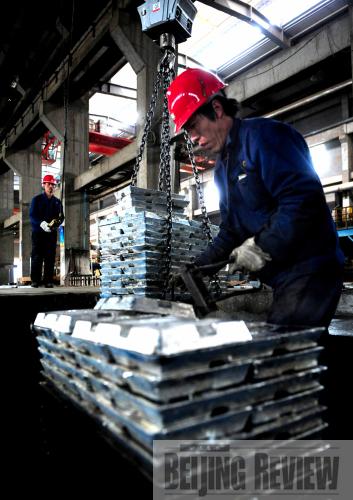|
 |
|
TIGHTENING UP: Many of China's nonferrous metal producers have streamlined operations and enhanced production technologies in order to survive industrial reshuffling in the midst of worldwide economic woes (REN JUNCHUAN) |
Severe economic woes have hit China's nonferrous metal sector after nearly a decade of high-speed growth. But in its latest move, the State Council, China's cabinet, on May 11 announced an industrial stimulus plan to help the nonferrous metal industry ride out the slump.
Wang Lixin, an industrial analyst with Umetal.com, said the plan has four main components: total production control, obsolete capacity elimination, technological transformation and industrial restructuring.
"While helping the nonferrous metal industry ride out the economic downturn and ensuring its steady development, the country has to focus on long-term industrial restructuring and upgrading," she said.
Through the three-year plan, the country will encourage the formation of three to five large competitive corporations with diversified businesses by 2011.
China will also adjust export rebates and encourage more preferential bank loans to the industry to support technological transformation and progress.
No new projects to develop electrolytic aluminium will be allowed in the next three years, according to the plan. More electrolytic aluminium producers will be allowed to buy electricity directly from electricity generators, instead of from power grid companies, to cut costs. Currently, 15 producers have already been licensed to do so.
The State Council also laid out guidelines to eliminate obsolete capacity and absorb excess capacity.
The plan serves China's long-term goals of energy saving, consumption reduction and internal control reinforcement among companies, which is conducive to the industry's long-term development, said Wen Xianjun, Deputy Director of the China Nonferrous Metals Industry Association.
Grim situation
China is the world's largest producer and consumer of nonferrous metals. In 2008, its total output of 10 major nonferrous metals reached 25.2 million tons, while total consumption hit 25.17 million tons.
Large companies with annual output value exceeding 5 million yuan ($732,064) generated added value of 576.6 billion yuan ($84.4 billion), or 1.9 percent of the country's GDP, and the industry directly provided jobs to 3 million people in 2008.
Yet the nonferrous metal sector has witnessed price drops since the second half of 2008, as the global financial crisis spilled over into the real economy. Alumina and electrolytic aluminium prices have fallen about 50 percent, while copper prices are off 70 percent from their peak.
The industry as a whole is facing the new and more austere economic reality and suffering large-scale losses. For major nonferrous producers, their inventories are overstocked, their efficiency has decreased, and as cash on hand dwindles, many are cutting production or shutting down plants.
Meanwhile, China is continuing to address latent problems within the industry, such as excess production capacity for certain products, industrial layout yet to be improved, low industrial concentration, a lack of stable and sufficient resource supply, and weak independent innovation competence.
Of these, analysts said low industrial concentration is the most protruding problem. Large backbone companies accounted for 33 percent of the industry's total output value in 2004, but only 28.27 percent in 2007. This has affected large companies' market influence and diminished their voice in the global arena.
Hope for the future
The Chinese Government has already offered a hand to the industry since the end of last year. The State Reserves Bureau bought 290,000 tons of electrolytic aluminium from eight domestic producers last December and another 300,000 tons this February. The bureau also purchased 59,000 tons of refined zinc and 30 tons of indium, a soft metallic element used in plating mirrors and aircraft bearings.
| 